Structural Features of Clostridium botulinum Neurotoxin Subtype A2 Cell Binding Domain
Abstract
:1. Introduction
2. Results and Discussion
2.1. Structure of HC/A2
2.2. Structure of HC/A2 in Complex with GD1a Receptor Ganglioside
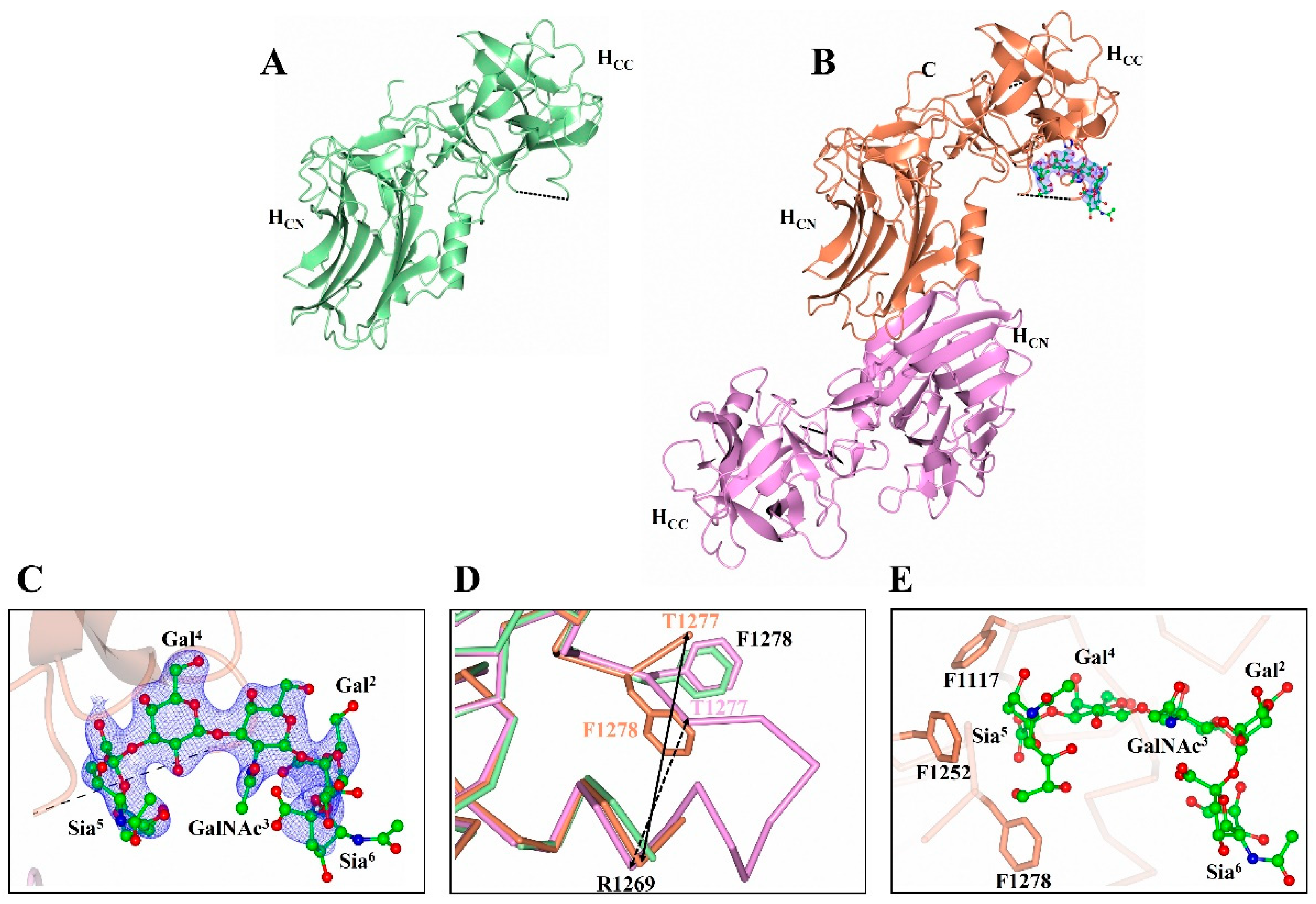
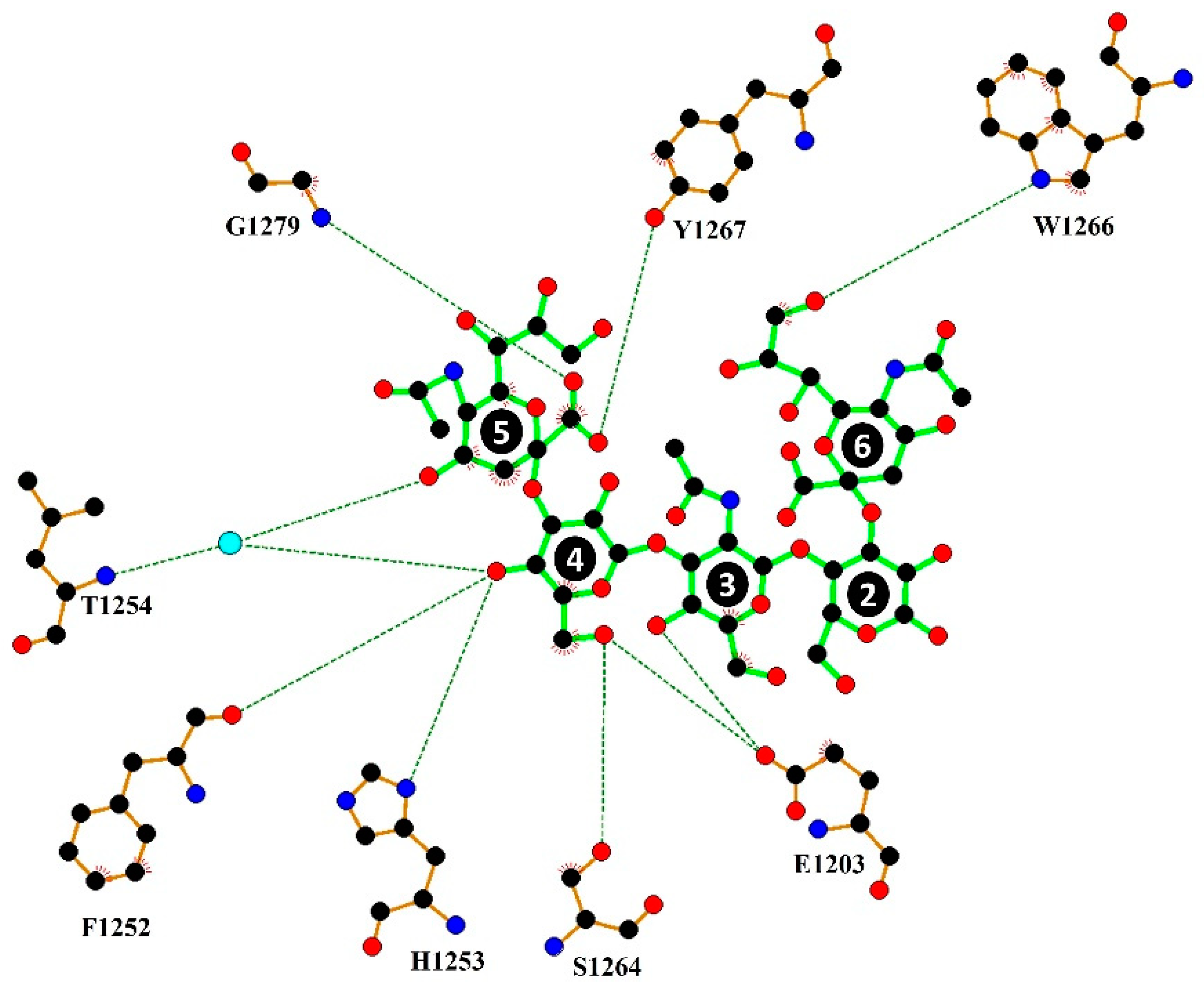
2.3. HC/A2 Is Primed for Receptor Binding
2.4. Hinge Motion between the HCN and HCC Subdomain
2.5. Lys 1236-X-Cys 1280 Bridge near the GBS
3. Conclusions
4. Materials and Methods
4.1. Expression and Purification of HC/A2
4.2. X-ray Crystallography
Author Contributions
Funding
Institutional Review Board Statement
Informed Consent Statement
Data Availability Statement
Acknowledgments
Conflicts of Interest
References
- Evidente, V.G.H.; Adler, C.H. An update on the neurologic applications of botulinum toxins. Curr. Neurol. Neurosci. Rep. 2010, 10, 338–344. [Google Scholar] [CrossRef] [PubMed]
- Monteucucco, C.; Schiavo, G.; Rossetto, O. The mechanism of action of tetanus and botulinum neurotoxins. Arch. Toxicol. 1996, 18, 342–354. [Google Scholar] [CrossRef]
- Webb, R.P. Engineering of botulinum neurotoxins for biomedical applications. Toxins 2018, 10, 231. [Google Scholar] [CrossRef] [PubMed] [Green Version]
- Masuyer, G.; Chaddock, J.A.; Foster, K.A.; Ravi Acharya, K. Engineered botulinum neurotoxins as new therapeutics. Annu. Rev. Pharmacol. Toxicol. 2014, 54, 27–51. [Google Scholar] [CrossRef] [PubMed]
- Chen, Z.P.; Glenn Morris, J.; Rodriguez, R.L.; Shukla, A.W.; Tapia-Núñez, J.; Okun, M.S. Emerging opportunities for serotypes of botulinum neurotoxins. Toxins 2012, 4, 1196–1222. [Google Scholar] [CrossRef] [Green Version]
- Hill, K.K.; Xie, G.; Foley, B.T.; Smith, T.J. Genetic diversity within the botulinum neurotoxin-producing bacteria and their neurotoxins. Toxicon 2015, 107, 2–8. [Google Scholar] [CrossRef] [Green Version]
- Tanizawa, Y.; Fujisawa, T.; Mochizuki, T.; Kaminuma, E.; Suzuki, Y.; Nakamura, Y.; Tohno, M. Draft genome sequence of Weissella oryzae SG25T, isolated from fermented rice grains. Genome Announc. 2014, 2, 3–4. [Google Scholar] [CrossRef] [Green Version]
- Zhang, S.; Lebreton, F.; Mansfield, M.J.; Miyashita, S.I.; Zhang, J.; Schwartzman, J.A.; Tao, L.; Masuyer, G.; Martínez-Carranza, M.; Stenmark, P.; et al. Identification of a botulinum neurotoxin-like toxin in a commensal strain of Enterococcus faecium. Cell Host Microbe 2018, 23, 169–176. [Google Scholar] [CrossRef] [Green Version]
- Zhang, S.; Masuyer, G.; Zhang, J.; Shen, Y.; Henriksson, L.; Miyashita, S.I.; Martínez-Carranza, M.; Dong, M.; Stenmark, P. Identification and characterization of a novel botulinum neurotoxin. Nat. Commun. 2017, 8, 14130. [Google Scholar] [CrossRef]
- Contreras, E.; Masuyer, G.; Qureshi, N.; Chawla, S.; Dhillon, H.S.; Lee, H.L.; Chen, J.; Stenmark, P.; Gill, S.S. A neurotoxin that specifically targets Anopheles mosquitoes. Nat. Commun. 2019, 10, 2869. [Google Scholar] [CrossRef]
- Montal, M. Botulinum neurotoxin: A marvel of protein design. Annu. Rev. Biochem. 2010, 79, 591–617. [Google Scholar] [CrossRef] [PubMed] [Green Version]
- Dong, M.; Yeh, F.; Tep, W.H.; Chapman, P.; Dean, C.; Johnson, E.A.; Janz, R.; Chapman, E.R. SV2 is the protein receptor for botulinum neurotoxin A. Science 2006, 312, 592–596. [Google Scholar] [CrossRef] [PubMed]
- Oblatt-Montal, M.; Yamazaki, M.; Nelson, R.; Montal, M. Formation of ion channels in lipid bilayers by a peptide with the predicted transmembrane sequence of botulinum neurotoxin A. Protein Sci. 1995, 4, 1490–1497. [Google Scholar] [CrossRef] [Green Version]
- Schmid, M.F.; Robinson, J.P.; Dasgupta, B. Direct visualization of botulinum neurotoxin-induced channels in phospholipid vesicles. Nature 1993, 364, 827–830. [Google Scholar] [CrossRef] [PubMed]
- Hoch, D.H.; Romero-Mira, M.; Ehrlich, B.E.; Finkelstein, A.; DasGupta, B.R.; Simpson, L.L. Channels formed by botulinum, tetanus, and diphtheria toxins in planar lipid bilayers: Relevance to translocation of proteins across membranes. Proc. Natl. Acad. Sci. USA 1985, 82, 1692–1696. [Google Scholar] [CrossRef] [PubMed] [Green Version]
- Dong, M.; Masuyer, G.; Stenmark, P. Botulinum and tetanus neurotoxins. Annu. Rev. Biochem. 2019, 88, 811–837. [Google Scholar] [CrossRef] [PubMed]
- Pirazzini, M.; Tehran, D.A.; Zanetti, G.; Megighian, A.; Scorzeto, M.; Fillo, S.; Shone, C.C.; Binz, T.; Rossetto, O.; Lista, F.; et al. Thioredoxin and its reductase are present on synaptic vesicles, and their inhibition prevents the paralysis induced by botulinum neurotoxins. Cell Rep. 2014, 8, 1870–1878. [Google Scholar] [CrossRef] [PubMed]
- Schiavo, G.; Rossetto, O.; Catsicas, S.; De Laureto, P.P.; DasGupta, B.R.; Benfenati, F.; Montecucco, C. Identification of the nerve terminal targets of botulinum neurotoxin serotypes A, D, and E. J. Biol. Chem. 1993, 268, 23784–23787. [Google Scholar] [CrossRef]
- Pellett, S.; Bradshaw, M.; Tepp, W.H.; Pier, C.L.; Whitemarsh, R.C.M.; Chen, C.; Barbieri, J.T.; Johnson, E.A. The light chain defines the duration of action of botulinum toxin serotype a subtypes. MBio 2018, 9, e00089-18. [Google Scholar] [CrossRef] [Green Version]
- Rossetto, O.; Montecucco, C. Tables of toxicity of botulinum and tetanus neurotoxins. Toxins 2019, 11, 686. [Google Scholar] [CrossRef] [Green Version]
- Whitemarsh, R.C.M.; Tepp, W.H.; Bradshaw, M.; Lin, G.; Pier, C.L.; Scherf, J.M.; Johnson, E.A.; Pellett, S. Characterization of botulinum neurotoxin A Subtypes 1 through 5 by investigation of activities in mice, in neuronal cell cultures, and in vitro. Infect. Immun. 2013, 81, 3894–3902. [Google Scholar] [CrossRef] [PubMed] [Green Version]
- Pellett, S.; Tepp, W.H.; Whitemarsh, R.C.M.M.; Bradshaw, M.; Johnson, E.A. In vivo onset and duration of action varies for botulinum neurotoxin A subtypes 1-5. Toxicon 2015, 107, 37–42. [Google Scholar] [CrossRef] [PubMed] [Green Version]
- Benoit, R.M.; Schärer, M.A.; Wieser, M.M.; Li, X.; Frey, D.; Kammerer, R.A. Crystal structure of the BoNT/A2 receptor-binding domain in complex with the luminal domain of its neuronal receptor SV2C. Sci. Rep. 2017, 7, 43588. [Google Scholar] [CrossRef] [PubMed] [Green Version]
- Gustafsson, R.; Zhang, S.; Masuyer, G.; Dong, M.; Stenmark, P. Crystal structure of botulinum neurotoxin A2 in complex with the human protein receptor SV2C reveals plasticity in receptor binding. Toxins 2018, 10, 153. [Google Scholar] [CrossRef] [PubMed] [Green Version]
- Davies, J.R.; Hackett, G.S.; Liu, S.M.; Acharya, K.R. High resolution crystal structures of the receptor-binding domain of Clostridium botulinum neurotoxin serotypes A and FA. PeerJ 2018, 2018, e4552. [Google Scholar] [CrossRef] [Green Version]
- Davies, J.R.; Rees, J.; Liu, S.M.; Acharya, K.R. High resolution crystal structures of Clostridium botulinum neurotoxin A3 and A4 binding domains. J. Struct. Biol. 2018, 202, 113–117. [Google Scholar] [CrossRef]
- Davies, J.R.; Britton, A.; Liu, S.M.; Acharya, K.R. High-resolution crystal structures of the botulinum neurotoxin binding domains from subtypes A5 and A6. FEBS Open Bio 2020, 10, 1474–1481. [Google Scholar] [CrossRef]
- Gregory, K.S.; Liu, S.M.; Acharya, K.R. Crystal structure of botulinum neurotoxin subtype A3 cell binding domain in complex with GD1a co-receptor ganglioside. FEBS Open Bio 2020, 10, 298–305. [Google Scholar] [CrossRef]
- Gregory, K.S.; Mojanaga, O.O.; Liu, S.M.; Acharya, K.R. Crystal structures of botulinum neurotoxin subtypes A4 and A5 cell binding domains in complex with receptor ganglioside. Toxins 2022, 14, 129. [Google Scholar] [CrossRef]
- Veevers, R.; Hayward, S. Biophysics and physicobiology movements in large biomolecular complexes. Biophys. Phys. 2019, 16, 328–336. [Google Scholar] [CrossRef] [Green Version]
- Yowler, B.C.; Schengrund, C.L.; Pennsyl, V. Botulinum neurotoxin A changes conformation upon binding to ganglioside GT1b. Biochemistry 2004, 43, 9725–9731. [Google Scholar] [CrossRef] [PubMed]
- Ruszkowski, M.; Dauter, Z. On methylene-bridged cysteine and lysine residues in proteins. Protein Sci. 2016, 25, 1734–1736. [Google Scholar] [CrossRef] [Green Version]
- Rabe von Pappenheim, F.; Wensien, M.; Ye, J.; Uranga, J.; Irisarri, I.; de Vries, J.; Funk, L.M.; Mata, R.A.; Tittmann, K. Widespread occurrence of covalent lysine–cysteine redox switches in proteins. Nat. Chem. Biol. 2022, 18, 368–375. [Google Scholar] [CrossRef] [PubMed]
- Wang, J. Crystallographic identification of spontaneous oxidation intermediates and products of protein sulfhydryl groups. Protein Sci. 2019, 28, 472–477. [Google Scholar] [CrossRef] [PubMed] [Green Version]
- Ruszkowski, M.; Dauter, Z. Comment on Wang’s paper on the covalent Cys-X-Lys bridges. Protein Sci. 2019, 28, 470–471. [Google Scholar] [CrossRef] [Green Version]
- Wensien, M.; von Pappenheim, F.R.; Funk, L.M.; Kloskowski, P.; Curth, U.; Diederichsen, U.; Uranga, J.; Ye, J.; Fang, P.; Pan, K.T.; et al. A lysine–cysteine redox switch with an NOS bridge regulates enzyme function. Nature 2021, 593, 460–464. [Google Scholar] [CrossRef]
- Davies, J.R. Structure-Function Studies on Clostridium Botulinum Neurotoxins. Ph.D. Thesis, University of Bath, Bath, UK, 2019. [Google Scholar]
- Waterman, D.G.; Winter, G.; Gildea, R.J.; Parkhurst, J.M.; Brewster, A.S.; Sauter, N.K.; Evans, G. Diffraction-geometry refinement in the DIALS framework. Acta Crystallogr. Sect. D Struct. Biol. 2016, 72, 558–575. [Google Scholar] [CrossRef] [Green Version]
- McCoy, A.J.; Grosse-Kunstleve, R.W.; Adams, P.D.; Winn, M.D.; Storoni, L.C.; Read, R.J. Phaser crystallographic software. J. Appl. Crystallogr. 2007, 40, 658–674. [Google Scholar] [CrossRef] [Green Version]
- Winn, M.D.; Ballard, C.C.; Cowtan, K.D.; Dodson, E.J.; Emsley, P.; Evans, P.R.; Keegan, R.M.; Krissinel, E.B.; Leslie, A.G.W.; McCoy, A.; et al. Overview of the CCP4 suite and current developments. Acta Crystallogr. Sect. D Biol. Crystallogr. 2011, 67, 235–242. [Google Scholar] [CrossRef] [Green Version]
- Vagin, A.A.; Steiner, R.A.; Lebedev, A.A.; Potterton, L.; McNicholas, S.; Long, F.; Murshudov, G.N. REFMAC5 dictionary: Organization of prior chemical knowledge and guidelines for its use. Acta Crystallogr. Sect. D Biol. Crystallogr. 2004, 60, 2184–2195. [Google Scholar] [CrossRef] [Green Version]
- Liebschner, D.; Afonine, P.V.; Baker, M.L.; Bunkoczi, G.; Chen, V.B.; Croll, T.I.; Hintze, B.; Hung, L.W.; Jain, S.; McCoy, A.J.; et al. Macromolecular structure determination using X-rays, neutrons and electrons: Recent developments in Phenix. Acta Crystallogr. Sect. D Struct. Biol. 2019, 75, 861–877. [Google Scholar] [CrossRef] [PubMed] [Green Version]
- Emsley, P.; Lohkamp, B.; Scott, W.G.; Cowtan, K. Features and development of Coot. Acta Crystallogr. Sect. D Biol. Crystallogr. 2010, 66, 486–501. [Google Scholar] [CrossRef] [PubMed] [Green Version]
- Williams, C.J.; Headd, J.J.; Moriarty, N.W.; Prisant, M.G.; Videau, L.L.; Deis, L.N.; Verma, V.; Keedy, D.A.; Hintze, B.J.; Chen, V.B.; et al. MolProbity: More and better reference data for improved all-atom structure validation. Protein Sci. 2018, 27, 293–315. [Google Scholar] [CrossRef] [PubMed]
- Berman, H.; Henrick, K.; Nakamura, H. Announcing the worldwide Protein Data Bank. Nat. Struct. Biol. 2003, 10, 980. [Google Scholar] [CrossRef]
- McNicholas, S.; Potterton, E.; Wilson, K.S.; Noble, M.E.M. Presenting your structures: The CCP4mg molecular-graphics software. Acta Crystallogr. Sect. D Biol. Crystallogr. 2011, 67, 386–394. [Google Scholar] [CrossRef] [Green Version]
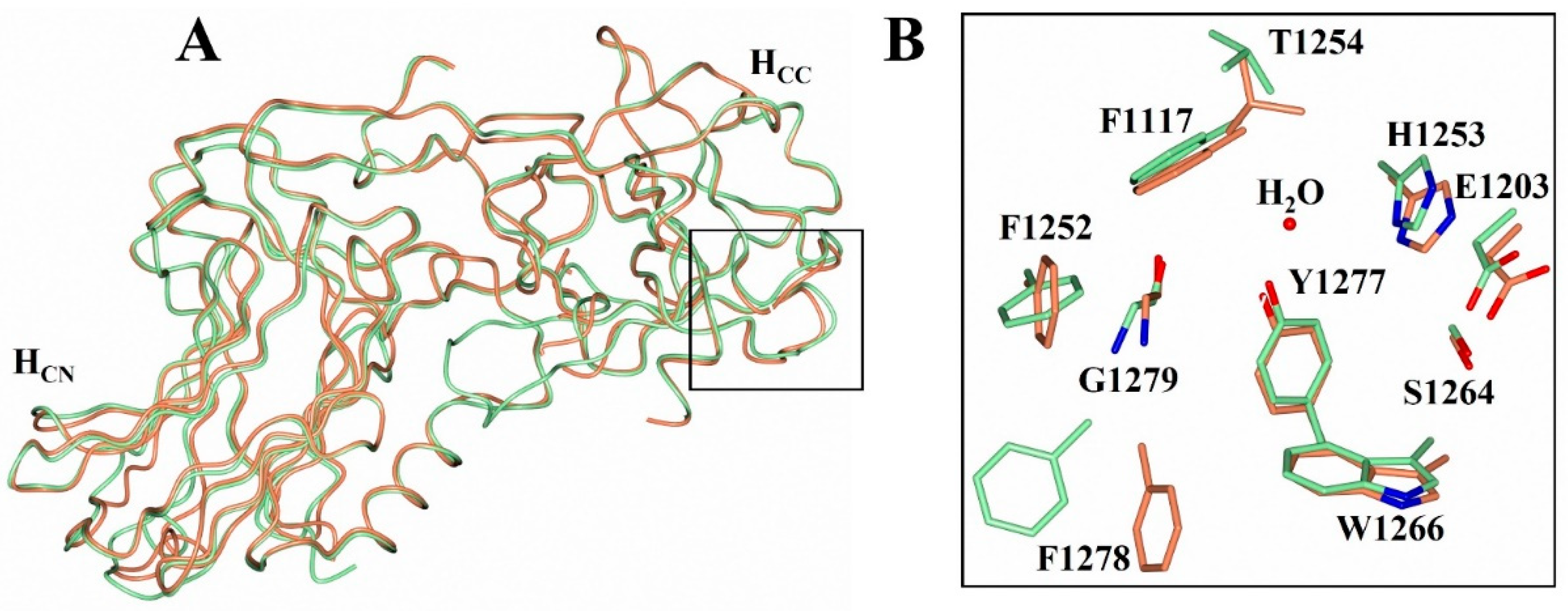
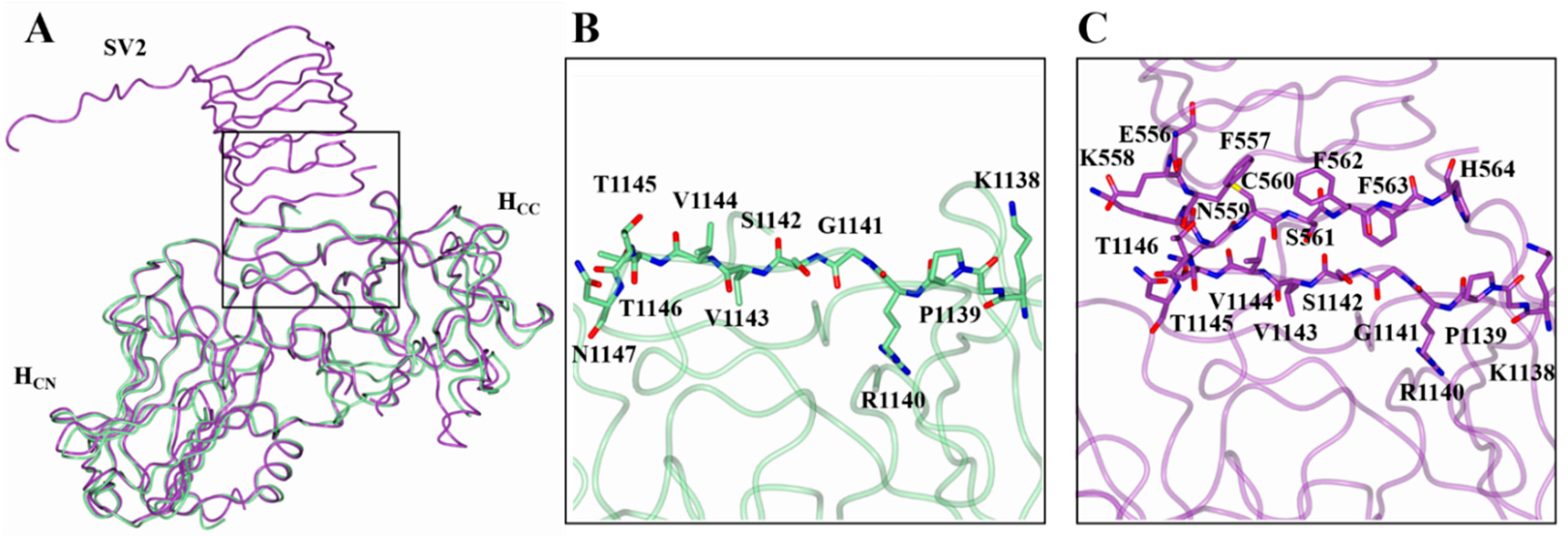
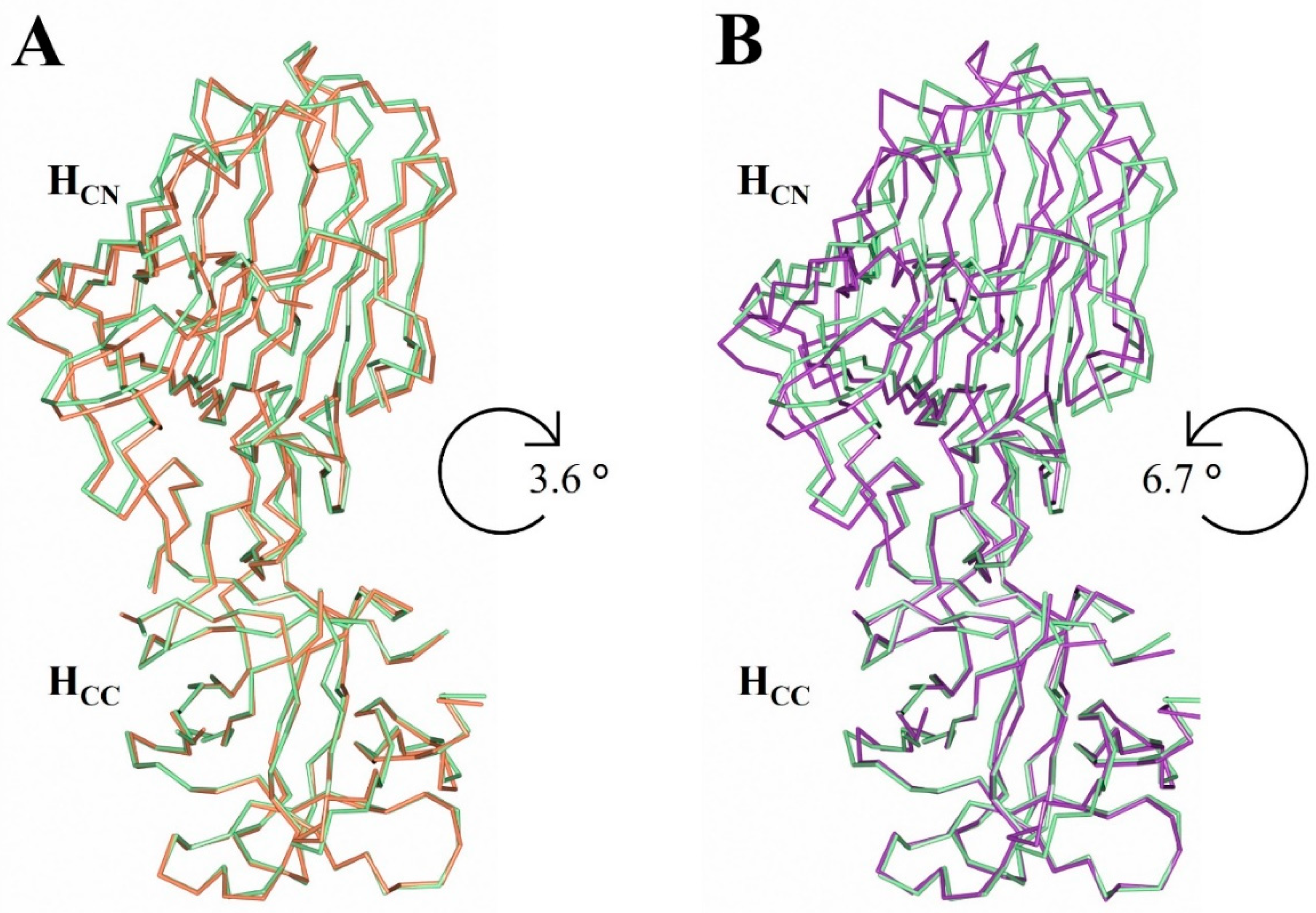
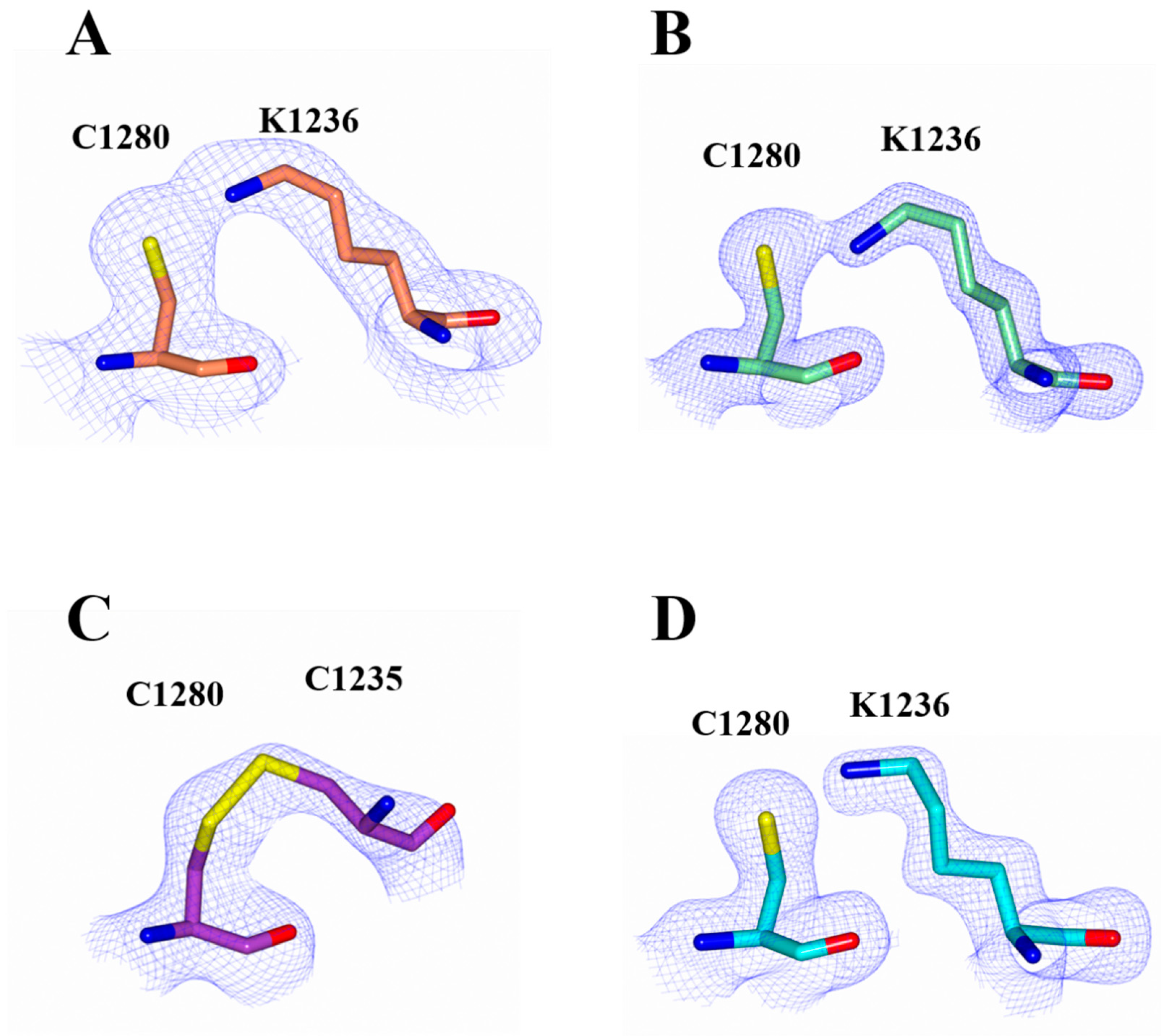
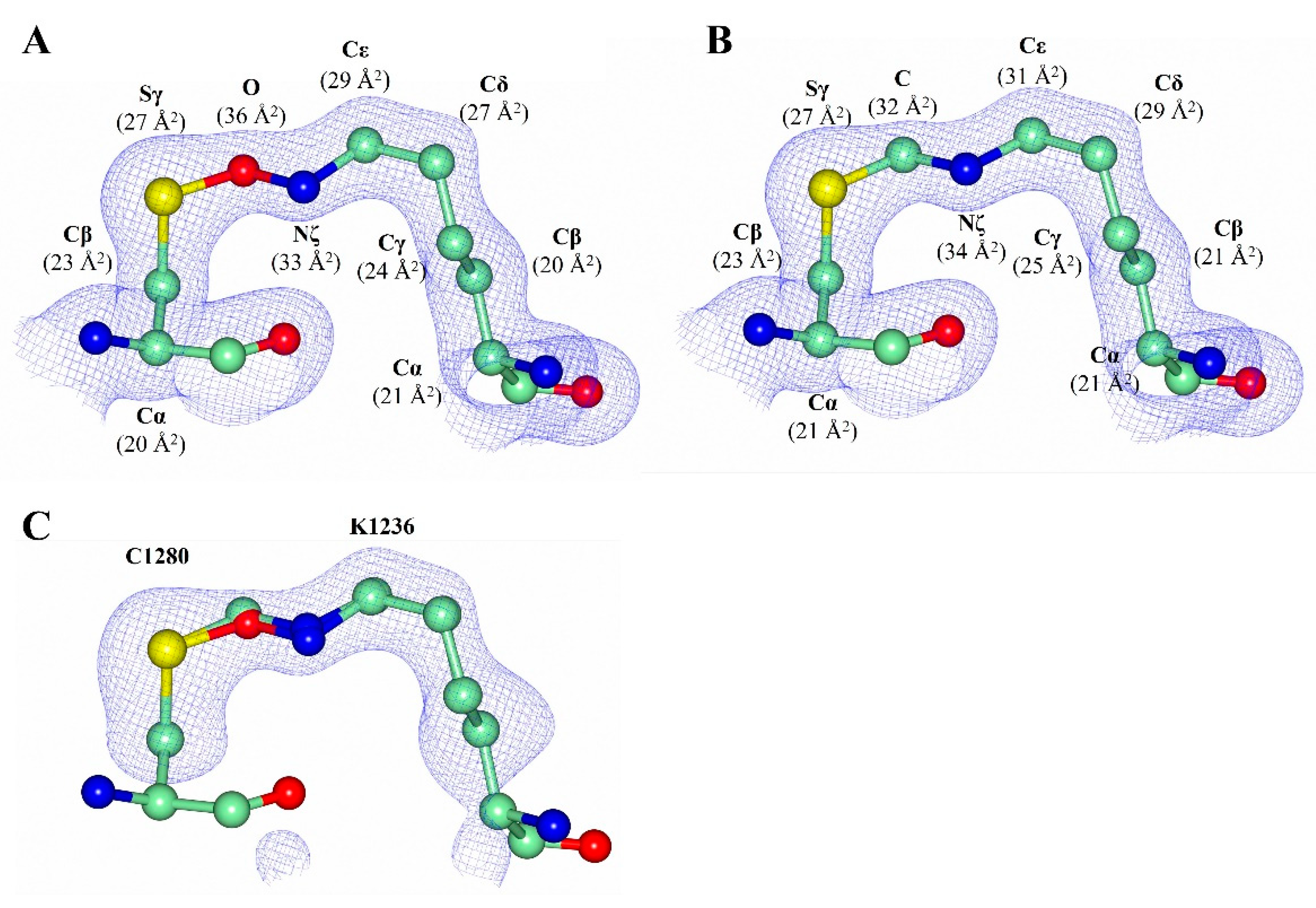
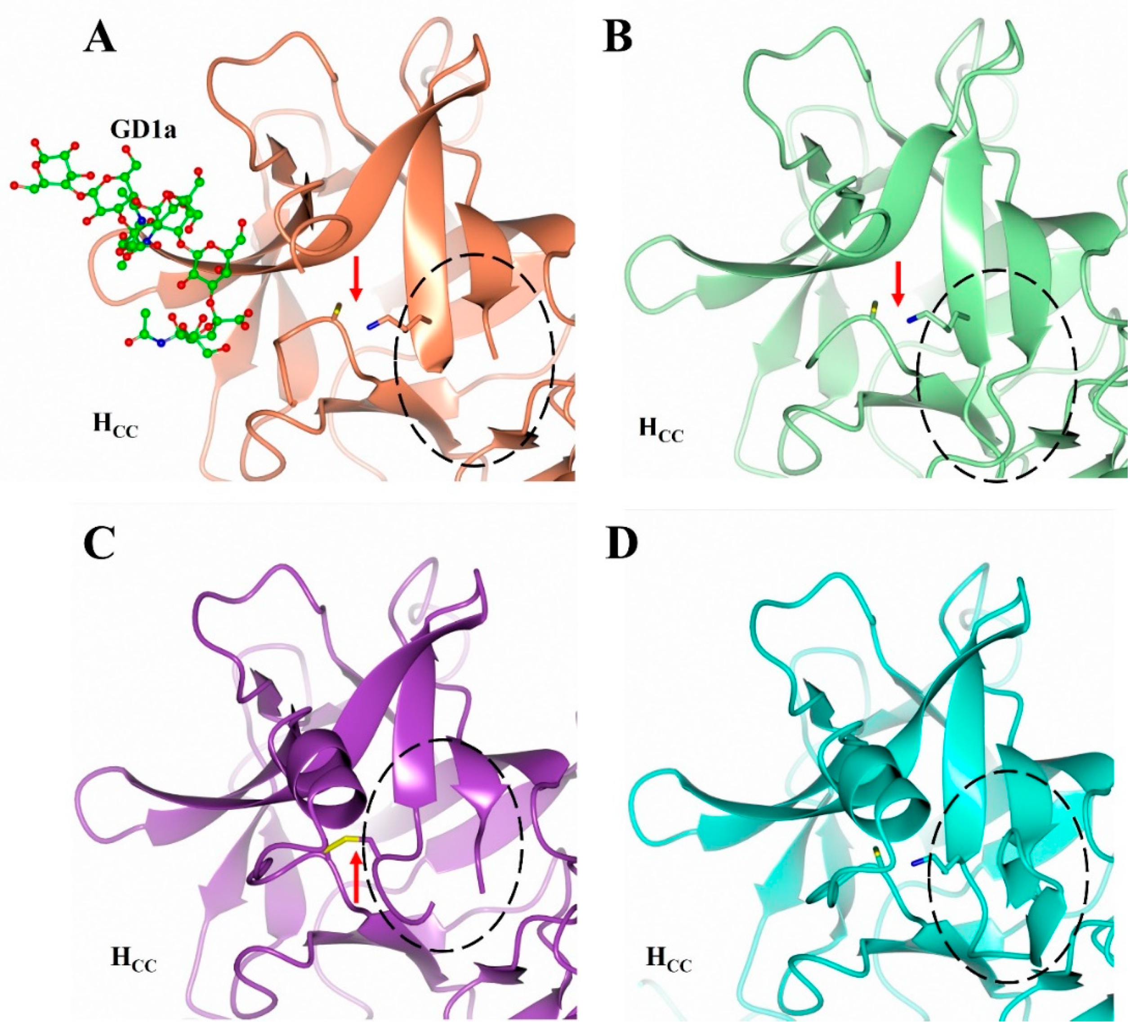
| Beamline | I04 | I04 |
| Wavelength | 0.9795 Å | 0.9795 Å |
| Protein | HC/A2 | HC/A2:GD1a |
| Crystallographic statistics | ||
| Space group | P 21 21 21 | P 41 |
| Unit cell dimensions | ||
| a, b, c (Å) | 39.92, 100.79, 116.15 | 105.07, 105.07, 132.58 |
| α, β, γ (°) | 90, 90, 90 | 90, 90, 90 |
| Resolution range (Å) | 116.15–1.63 (1.66–1.63) | 105.07–2.10 (2.14–2.10) |
| Rmerge | 0.159 (5.530) | 0.246 (3.916) |
| Rpim | 0.031 (1.087) | 0.048 (0.847) |
| <I/σ(I)> | 11.6 (0.7) | 11.1 (0.9) |
| CC1/2 | 0.999 (0.299) | 0.999 (0.400) |
| Completeness (%) | 100.00 (99.90) | 100.00 (100.00) |
| No. observed reflections | 1,563,838 (77,009) | 2,288,498 (4633) |
| No. unique reflections | 59,567 (2930) | 83,782 (4633) |
| Multiplicity | 26.3 (26.3) | 27.3 (21.9) |
| Refinement Statistics | ||
| Rwork/Rfree | 0.205/0.233 | 0.189/0.227 |
| RMSD bond lengths (Å) | 0.011 | 0.010 |
| RMSD bond angles (°) | 1.53 | 1.61 |
| Ramachandran plot statistics (%) | ||
| Favoured | 96.00 | 95.00 |
| Allowed | 4.00 | 5.00 |
| Outliers | 0.00 | 0.00 |
| Average B-Factors (Å2) | 32.80 | 48.6 |
| Protein atoms | 32.52 | 44.98 |
| Solvent atoms | 36.94 | 46.24 |
| GD1a ligand | N/A | 84.2 |
| No. Atoms | 3606 | 7143 |
| Protein | 3372 | 6733 |
| Solvent | 234 | 333 |
| GD1a | N/A | 77 |
| PDB code | 7Z5T | 7Z5S |
Publisher’s Note: MDPI stays neutral with regard to jurisdictional claims in published maps and institutional affiliations. |
© 2022 by the authors. Licensee MDPI, Basel, Switzerland. This article is an open access article distributed under the terms and conditions of the Creative Commons Attribution (CC BY) license (https://creativecommons.org/licenses/by/4.0/).
Share and Cite
Gregory, K.S.; Mahadeva, T.B.; Liu, S.M.; Acharya, K.R. Structural Features of Clostridium botulinum Neurotoxin Subtype A2 Cell Binding Domain. Toxins 2022, 14, 356. https://doi.org/10.3390/toxins14050356
Gregory KS, Mahadeva TB, Liu SM, Acharya KR. Structural Features of Clostridium botulinum Neurotoxin Subtype A2 Cell Binding Domain. Toxins. 2022; 14(5):356. https://doi.org/10.3390/toxins14050356
Chicago/Turabian StyleGregory, Kyle S., Tejaswini B. Mahadeva, Sai Man Liu, and K. Ravi Acharya. 2022. "Structural Features of Clostridium botulinum Neurotoxin Subtype A2 Cell Binding Domain" Toxins 14, no. 5: 356. https://doi.org/10.3390/toxins14050356
APA StyleGregory, K. S., Mahadeva, T. B., Liu, S. M., & Acharya, K. R. (2022). Structural Features of Clostridium botulinum Neurotoxin Subtype A2 Cell Binding Domain. Toxins, 14(5), 356. https://doi.org/10.3390/toxins14050356





